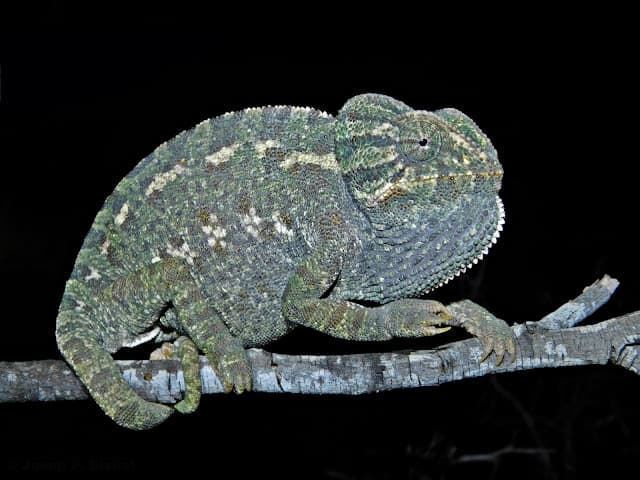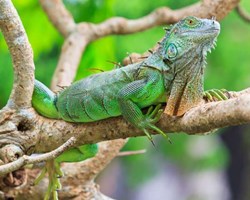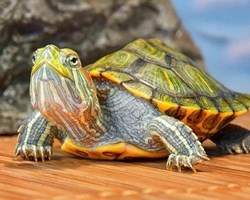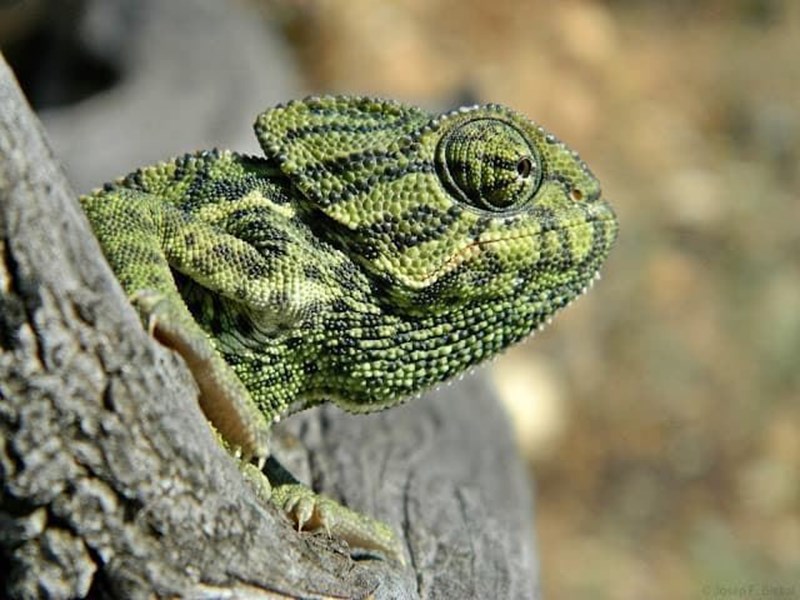
DESCRIPTION OF THE COMMON CHAMELEON:
The common chameleon or Chamaeleo chamaeleon is a species with an arched body but compressed on the side.
It has a variable background color, as it is one of the animals that change color, a hard head and characterized by a pointed shape, like a crest, on the back.
Their eyes are very prominent and they have a long tongue that is capable of reaching great distances to catch their food.
Characteristics:
Class: Reptiles.
Order: Squamous.
Family: Chameleons.
Length: 15-30cm.
Distribution: North Africa, southern Iberian Peninsula, island of Crete, southwestern Asia.
Habitat: Bushes, forests, open land with abundant vegetation.
Food: Insectivorous.
Laying: 7-40 eggs.
Incubation: More than 280 days (the following summer).
Sexual maturity: 1 year.

This species has a laterally compressed body, with a high and narrow head, the eyes protected by a membrane and with the possibility of movement in all directions, even backwards and independently.
In adults, the head is characterized by having a helmet raised posteriorly in the shape of a triangular pyramid.
Also characterized by having a long and prehensile tail.
Like the other chameleons, it has fingers arranged in the shape of a pincer, divided into two groups of two and three elements respectively.
The coloration of the upper parts varies in relation to the state of mind and the health conditions of the animal, it can be gray, green or brown, with or without spots and longitudinal bands on the flanks.
Medium-sized reptile (28-30 cm total head-tail length).
Laterally compressed body, head with a well-developed crest, prominent eyes covered with a conical eyelid, prehensile tail and opposite fingers in groups of two and three, forming pincers.
The eyes can move in all directions and independently of each other.
It has the ability to change color very quickly thanks to a complex system of pigment structures in skin cells.
This allows him to camouflage himself with the environment adapted to the color of what surrounds him.
The common chameleon or Mediterranean chameleon, Chamaeleo chamaeleon, is an iguanian reptile of the Chamaeleonidae family.
It is a species of circum-Mediterranean distribution that is present in most of North Africa, the Mediterranean area of the Middle East, the Arabian Peninsula, continental Greece, Anatolia and in several islands of the Aegean Sea, Malta and Sicily.
At some point in the last few millennia, it colonized the Iberian Peninsula, possibly due to human intervention.
It is distributed along the Atlantic and Mediterranean coast of Andalusia and the Algarve, although in recent decades its distribution has been expanding.
This has caused the appearance of new populations in Murcia and in recent years, also in the south and center of C. Valenciana, with human intervention clearly being the origin of this great expansion of its distribution towards the north.
The common chameleon is fully adapted to arboreal life thanks to its opposable fingers and prehensile tail.
Its large, prominent eyes can move autonomously, giving the animal stereoscopic vision.
Body coloration is highly variable due to sexual dichromatism, with very complex patterns related to sex, reproductive status and the thermoregulatory needs of individuals.
It has a long, sticky, projectable and retractable tongue, with which it catches its prey from a distance, which it hunts on the prowl among the vegetation.
The common chameleon is fundamentally insectivorous, with most of its diet consisting of small Diptera, although it also consumes Hymenoptera, Heteroptera, Orthoptera, Arachnids, Odonate, Mantodean and Lepidoptera.
Likewise, cases of cannibalism of adult individuals on juveniles of the same species have been documented.
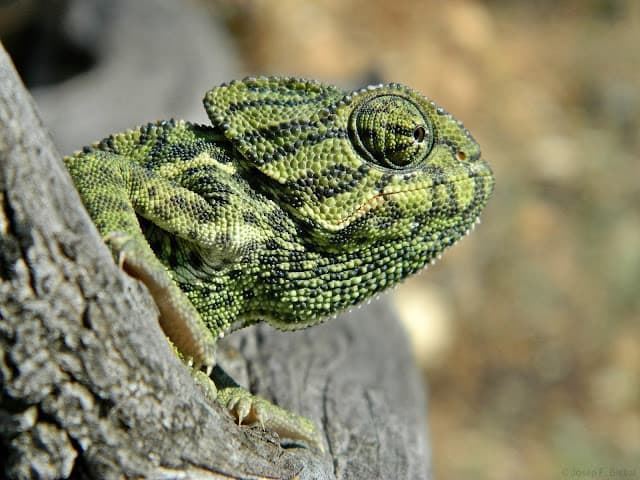
WHERE DO YOU LIVE (HABITAT):
It prefers woody crops, such as olive groves, almond trees, orchards and areas of open scrub such as broom.
It also appears in lots and gardens around population centers.
In general, it prefers dry and warm environments, with scattered tree or bush vegetation in which to take refuge, blending in with its branches and leaves.
It avoids mountain areas and strays little from the coastal strip.
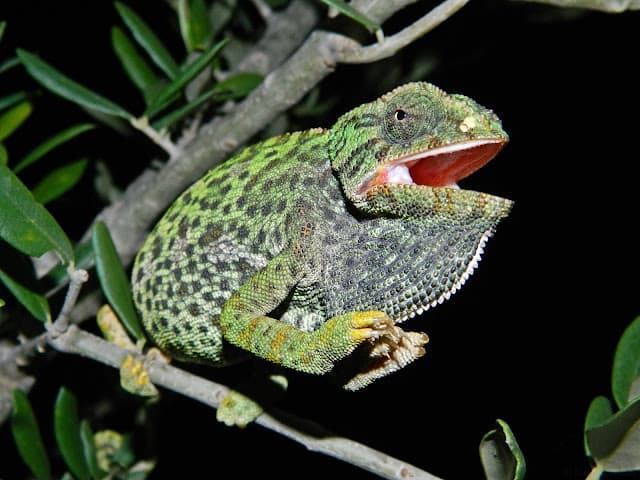
HOW YOU LIVE:
Arboreal species that feeds on medium-sized flying insects that it captures by launching its long and sticky tongue.
Its hunting strategy consists of stalking prey while remaining almost static, although with a continuous movement of its eyes.
Once a possible prey is detected, it moves very slowly, directing both eyes at the target, obtaining an accurate measurement of the distance, and finally launching its very long tongue at dizzying speed to catch the victim with its sticky and thickened tip.
It is a solitary animal, except in the mating season.
It spends the coldest months hibernating in tree hollows, although on warm winter days it can be active during the sunniest hours.
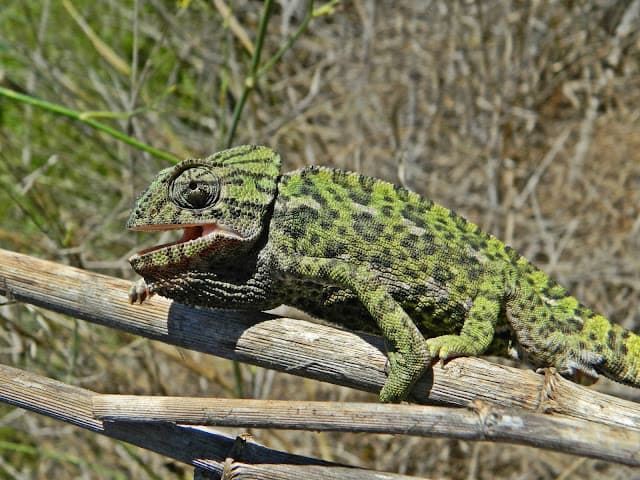
NUTRITION FOR THE COMMON CHAMELEON:
It feeds mainly on insects, which it captures with its large tongue, which exceeds the length of the body, thanks to its sticky end.
REPRODUCTION OF THE COMMON CHAMELEON:
The female is oviparous and lays her eggs in a hole dug in the ground near the thicket.
Their reproductive activity takes place in the summer and early fall.
Courtship is very simple and consists of the male chasing the female.
Once fertilized, the female is aggressive towards males.
Egg laying takes place in the month of October. The female descends to the ground and lays 7 to 40 eggs that hatch the following summer.
The heat period usually occurs between the end of July and mid-September.
Males come down from trees and bushes and actively search for females.
When they find a female they defend the territory around her from other competitors.
In autumn, the females dig a gallery in the ground, where they lay between 10 and 30 eggs.
The young will not hatch until the following summer.
The newly hatched pups have an instinct to quickly climb a tree or bush near where they were born.
Female common chameleons are oviparous and lay their eggs in a hole dug in the ground, usually at the base of a thicket.
Their reproductive activity takes place throughout the summer and early autumn.
The mating ritual is very simple and consists of an insistent pursuit of the female by the male, until copulation is achieved.
Once fertilized, the female is aggressive towards the males, rejecting them.
Egg laying normally takes place during the month of October, when the female lays up to 40 eggs that hatch the following summer, although hatchings of up to three years have been recorded in captivity.
Juvenile individuals are exactly the same as adults, although they have a less developed cranial crest.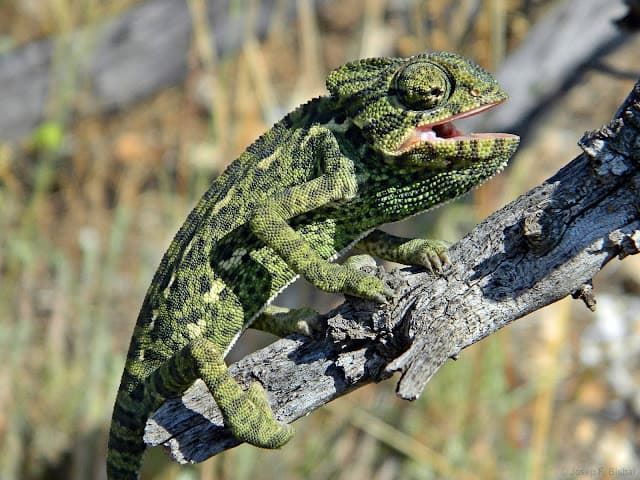
CUSTOMS AND SOCIAL LIFE:
The chameleon normally lives in the bushes, but often goes down to the ground, where it moves with slow and heavy movements.
Its maximum activity takes place during daylight hours.
When disturbed it swells up and threatens with its mouth open.
It is a solitary and territorial animal; markedly intolerant towards his congeners, except in the period of heat.
To mark its territory, it stands in places where it can be easily seen and, if another individual appears, it begins a series of threatening movements and color changes to dissuade it.
In mid-autumn, with the drop in temperatures, they become lethargic and remain hidden until the following spring, although some isolated specimens can be seen in the hot sand.
The young are active throughout the year.
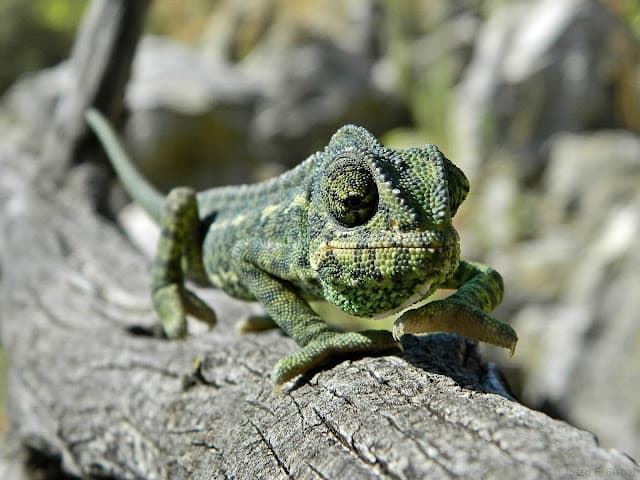
STATE OF CONSERVATION:
In Spain it is considered in danger of extinction.
The cause of the drastic decrease in their populations is above all the destruction of their coastal habitat, due to the proliferation of new urbanizations.
